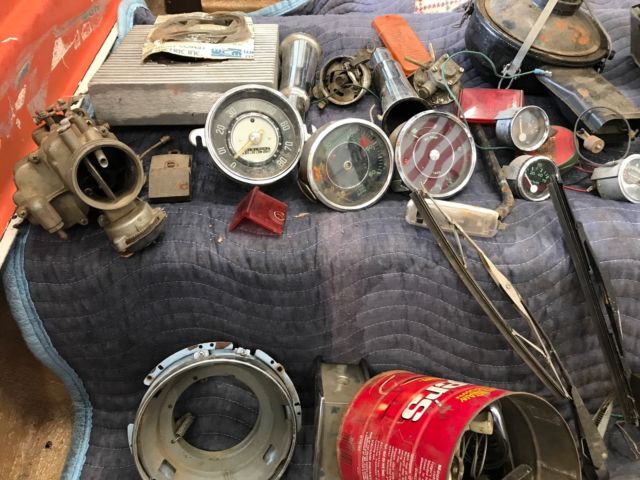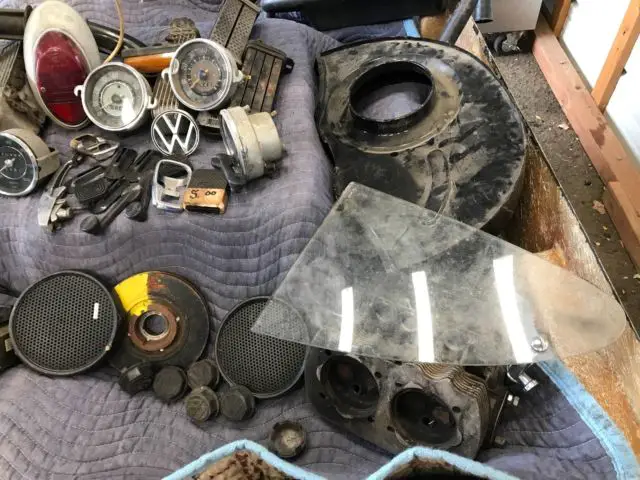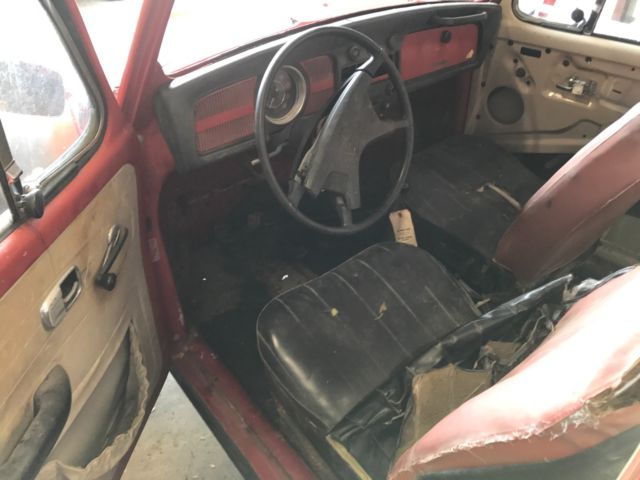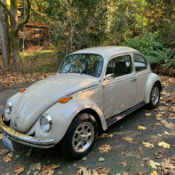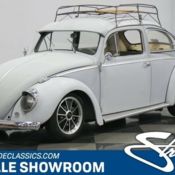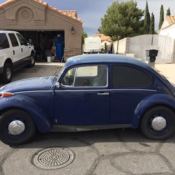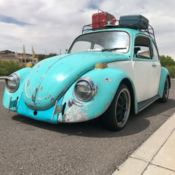1970 VW Beetle Truck full of classic parts all original German classic complete
1968 Volkswagen Beetle - Classic
Great barn find, clean little car I put a new gas tank into the car to hear it run runs fine. I suppose the trans is in good shape looks good finds the gears. Hood fiberglass bed glass chalk full of great parts all gauges and parts!!!!!What you see is what you get as-is good Colorado title. I'll do my best to answer questions I'll sell it before the auction ends because no one ever pays. THANKS 303-425-8707We can help your transport company move this bug onto your truck at point of sale.
Open main menuSearch
- Edit
- Watch this page
- Read in another language
TheVolkswagen Beetle- officially theVolkswagen Type 1, informally inGermanytheKäfer(German, "beetle") and in parts of the English-speaking world theBug- is a two-door, four-passenger, rear-engineeconomy carthat was manufactured and marketed by German automakerVolkswagen(VW) from 1938 until 2003.[11]
| Volkswagen |
| "Beetle"[1]/ "Super Beetle"[2] "Bug" / "Superbug"[3] "Käfer"[4] "Type 1" "1302"[5] |
| 1938-2003: 21,529,464 built (15,444,858 in Germany, incl. 330,251 Cabriolets)[6] (≈ 3,350,000 in Brazil) |
| Germany:Wolfsburg Germany:Hanover Germany:Emden Germany:Ingolstadt Germany:Osnabrück Australia:Melbourne Belgium:Brussels Brazil:São Bernardo do Campo Finland:Heinola[7] Indonesia:Jakarta Ireland:Dublin Malaysia:Shah Alam[8] Mexico:Puebla New Zealand:Auckland Nigeria:Lagos Philippines:Manila South Africa:Uitenhage Venezuela:Valencia[9] Yugoslavia:Sarajevo |
| Subcompact,economy car |
|
| RR layout |
|
|
| 2,400mm (94.5in) |
| 4,079mm (160.6in) |
| 1,539mm (60.6in) |
| 800-840kg (1,760-1,850lb)[10] |
|
The need for this kind of car, and its functional objectives, was formulated by the leader ofNazi Germany,Adolf Hitler, who wanted a cheap, simple car to be mass-produced for his country's newroad network. Porsche and his team took until 1938 to finalise the design. The influence on Porsche's design of other contemporary cars, such as theTatra V570, and the work ofJosef Ganzremains a subject of dispute.[12]The result was one of the firstrear-enginedcars since theBrass Era. With 21,529,464 produced,[13]the Beetle is the longest-running andmost-manufactured carof a singleplatformever made.
Although designed in the 1930s, the Beetle was only produced in significant numbers from 1945 on (mass production had been put on hold during theSecond World War) when the model was internally designated the Volkswagen Type 1, and marketed simply as the Volkswagen (or "People's Car"). Later models were designated Volkswagen 1200, 1300, 1500, 1302 or 1303, the former three indicatingengine displacement, the latter two derived from the type number. The model became widely known in its home country as theKäfer(German for "beetle") and was later marketed as such in Germany,[4]and as the Volkswagen in other countries. For example, inFranceit was known as theCoccinelle(French forladybug).[1][2]
The original 25hp Beetle was designed for a top speed around 100km/h (62mph), which would be a viable speed on theReichsautobahnsystem. As Autobahn speeds increased in the postwar years, its output was boosted to 36, then 40hp, the configuration that lasted through 1966 and became the "classic" Volkswagen motor. The Beetle ultimately gave rise to variants, including theKarmann Ghia,Type 2and external coach builders. The Beetle marked a significant trend, led by Volkswagen,Fiat, andRenault, whereby therear-engine, rear-wheel-drive layoutincreased from 2.6percent of continental Western Europe's car production in 1946 to 26.6percent in 1956.[14]The 1948Citroën 2CVand other European models marked a later trend tofront-wheel drivein the European small-car market, a trend that would come to dominate that market. In 1974, Volkswagen's own front-wheel driveGolfmodel succeeded the Beetle. In 1994, Volkswagen unveiled theConcept One, a "retro"-themedconcept carwith a resemblance to the original Beetle, and in 1998 introduced the "New Beetle", built on thecontemporary Golfplatform with styling recalling the original Type 1. It remained in production through 2010, being succeeded in 2011 by the more aggressively styledBeetle (A5), which was also more reminiscent of the original Beetle.
In the 1999Car of the Centurycompetition, to determine the world's most influential car in the 20th century, the Type 1 came fourth, after theFord Model T, theMini, and theCitroën DS.[15]
HistoryEditFerdinand Porsche[note 1][16]"The People's Car"EditModel of the 1932 Porsche Type 12, Nuremberg Museum of Industrial CultureType 32 prototype, developed for NSU (Autostadt ZeitHaus, Wolfsburg)Scale modelof the W30 prototypeIn April 1934, Adolf Hitler gave the order toFerdinand Porscheto develop aVolkswagen(literally, "people's car" in German, pronounced[ˈfÉ”lksvaËÉ¡É™n]).[17]The epithetVolks-literally, "people's-" had been applied to other Nazi-sponsored consumer goods such as theVolksempfänger("people's radio").
In May 1934, at a meeting at Berlin'sKaiserhof Hotel,Chancellor Hitlerinsisted on a basic vehicle that could transport two adults and three children at 100km/h (62mph) while not using more than 7 litres of fuel per 100km (32 mpg US/39 mpg UK).[12]The engine had to be powerful for sustained cruising on Germany's newAutobahnen. Everything had to be designed to ensure parts could be quickly and inexpensively exchanged. The engine had to beair-cooledbecause, as Hitler explained, not every country doctor had his own garage. (Ethylene glycolantifreezewas only just beginning to be used in high-performanceliquid-cooledaircraft engines. In general, radiators filled with water would freeze unless the vehicle was kept in a heated building overnight or drained and refilled each morning.)[18]
The "People's Car" would be available to citizens ofNazi Germanythrough a savings scheme, orSparkarte(savings booklet),[19]at 990Reichsmark, about the price of a small motorcycle. (The average weekly income was then around 32RM.)[20]
DevelopmentEditKdFPropaganda: "A family playing by a river with a KdF-Wagen and radio receiver"Ferdinand Porsche developed theType 12, or "Auto für Jedermann" (car for everybody) forZündappin 1931. Porsche already preferred theflat-four engine, and selected aswing axlerear suspension (invented byEdmund Rumpler), while Zündapp insisted on awater-cooledfive-cylinderradial engine. In 1932, three prototypes were running.[21]All of those cars were lost duringWorld War II, the last in a bombing raid inStuttgartin 1945.
The Zündapp prototypes were followed by the Porsche Type 32, designed in 1933 forNSU Motorenwerke AG, another motorcycle company. The Type 32 was similar in design to the Type 12, but it had a flat-four engine. NSU's exit from car manufacturing resulted in the Type 32 being abandoned at the prototype stage.[22]
Initially designated Type 60 by Porsche, the design team includedErwin KomendaandKarl Rabe. In October 1935, the first two Type 60 prototypes, known as theV1andV2(V forVersuchswagen, or "test car"), were ready.[23]In 1936, testing began of three furtherV3prototypes,[23]built in Porsche'sStuttgartshop.[24]A batch of thirtyW30development models, produced for Porsche byDaimler-Benz,[23][25]underwent 1,800,000mi (2,900,000km)[25]of further testing in 1937. All cars had the distinctive round shape and theair-cooled, rear-mountedengine. Included in this batch was a rollback soft top called the Cabrio Limousine.[26]A further batch of 44VW38pre-production cars produced in 1938 introduced split rear windows; both the split window and the dash were retained on production Type 1s until 1953.[25]The VW38 cars were followed by another batch of 50VW39cars, completed in July 1939.[27]
The car was designed to be as simple as possible mechanically. The air-cooled 25hp(19kW) 995cc (60.7cuin)[28]motors' built-in oil cooler andflat-four engineconfiguration's superior performance was also effective for the GermanAfrika Korpsin Africa's desert heat. The suspension design used compacttorsion barsinstead ofcoilorleaf springs. The Beetle is nearly airtight and will briefly float.[29]
FactoryEditOn 26 May 1938, Hitler laid the cornerstone for the Volkswagen factory inFallersleben.[11]He gave a speech, in which he named the carKraft-durch-Freude-Wagen("Strength Through Joy Car", usually abbreviated toKdF-Wagen).[30]The name refers toKraft durch Freude('Strength Through Joy'), the official leisure organization ofNazi Germany. Themodel villageofStadt des KdF-Wagenswas created near Fallersleben inLower Saxonyin 1938 for the benefit of the workers at the newly built factory.
The factory had only produced a handful of cars by the start of the war in 1939; the first volume-produced versions of the car'schassiswere military vehicles, the Type 82Kübelwagen(approximately 52,000 built) and the amphibious Type 166Schwimmwagen(about 14,000 built).
The first Beetles were produced on a small scale in 1941.[11]
Wartime productionEditFront view of a Wehrmacht Typ 82E indunkelgelbPictures like these have led to years of rumours that Beetles served with the Afrika Corps further perpetuated by a Model Kit box. No beetle served in North Africa. The closest they got was a pre-war publicity drive to Afghanistan explaining some desert pictures (of civilian beetles), however the 82E was in fact used only after the war by serving English Army Officers and staff of the re-opened factory.A handful of KdF-Wagens were produced, primarily for theNazielite from 1941 to 1944, as the Typ 60. The factory also built theKübelwagen(Typ 82),Schwimmwagen(Typ 166), and a handful of other variants, asWehrmachtcombat vehicles. It produced small numbers ofKommandeurswagen(Typ 87), with a Typ 1 body mounted on afour-wheel driveSchwimmwagenchassis; the fenders were widened to accommodateKronprinzall-terrain tires (reminiscent of the laterBaja Bugs).[31]Kommandeurswagenwere produced up to 1944, when all production was halted because of heavy damage to the factory from Allied air raids. Much of the essential equipment had already been moved to underground bunkers for protection, which let production resume quickly after hostilities ended. Due to gasoline shortages late in the war, a few "Holzbrenner" Beetles were built, powered bypyrolysisgas producerslocated under the front hood.
Post-war production and boomEdit1949 Type 1 split-window (known as a "pretzel" among enthusiasts, "split" or "splitty") was commonly used to describe transporters of the era.1949 Type 1 interiorIn occupied Germany, the Allies followed theMorgenthau planto remove all German war potential by complete or partial pastoralization. As part of this, in theIndustrial plans for Germany, the rules for which industry Germany was to be allowed to retain were set out. German car production was set at a maximum of 10% of the 1936 car production numbers.[32]
Mass production of civilian VW cars did not start untilpost-war occupation. The Volkswagen factory was handed over by the Americans to British control in 1945; it was to be dismantled and shipped to Britain.[33]Thankfully for Volkswagen, no British car manufacturer was interested in the factory; an official report included the phrases "the vehicle does not meet the fundamental technical requirement of a motor-car... it is quite unattractive to the average buyer... To build the car commercially would be a completely uneconomic enterprise."[33]The factory survived by producing cars for theBritish Armyinstead.[33]Allied dismantling policy changed in late 1946 to mid-1947, although heavy industry continued to be dismantled until 1951. In March 1947,Herbert Hooverhelped change policy by stating
There is the illusion that the New Germany left after theannexationscan be reduced to a "pastoral state". It cannot be done unless we exterminate or move 25,000,000 people out of it.[34]
The re-opening of the factory is largely accredited to British Army officer MajorIvan Hirst.[35]Hirst was ordered to take control of the heavily bombed factory, which the Americans had captured. His first task was to remove an unexploded bomb that had fallen through the roof and lodged itself between some pieces of irreplaceable production equipment; if the bomb had exploded, the Beetle's fate would have been sealed. Knowing Germany needed jobs and the British Army needed vehicles,[36]Hirst persuaded the British military to order 20,000cars,[20]and by March 1946 the factory was producing 1,000cars a month (in Army khaki, under the name Volkswagen Type 1),[37]which Hirst said "was the limit set by the availability of materials".[37]During this period, the car reverted to its original name of Volkswagen and the town was renamedWolfsburg. The first 1,785Type 1s were made in 1945.
The jeweled one-millionth Type 1Following the British Army-led restart of production and Hirst's establishment of sales network and exports to Netherlands, formerOpelmanager (and formerly a detractor of the Volkswagen)Heinz Nordhoffwas appointed director of the Volkswagen factory in 1949.[20][33]Under Nordhoff, production increased dramatically over the following decade, with the one-millionth car coming off the assembly line by 1955. During this post-war period, the Beetle had superior performance in its category with a top speed of 115km/h (71mph) and 0-100km/h (0-62mph) in 27.5seconds with fuel consumption of 6.7l/100km (36mpg) for the standard 25kW (34hp) engine. This was far superior to theCitroën 2CV, which was aimed at a low speed/poor road rural peasant market, andMorris Minor, designed for a market with no motorways or freeways; it was even competitive with more advanced smallcity carslike theAustin Mini.
InSmall Wonder, Walter Henry Nelson wrote:
The engine fires up immediately without a choke. It has tolerable road-handling and is economical to maintain. Although a small car, the engine has great elasticity and gave the feeling of better output than its small nominal size.[citation needed]
There were other, less-numerous models, as well. TheHebmüllercabriolet (officiallyType 14A), a sporty two-seater, was built between 1949 and 1953; it numbered 696. TheType 18A, a fixed-top cabriolet, was produced byAustro-Tatraas a police and fire unit; 203 were assembled between January 1950 and March 1953.[38]
The chassis became a technological and parts donor toVolkswagen Type 2[39](also known asBulli) and externalcoachbuilderslikeRometsch,Dannenhauer & Stauss,Wilhelm Karmann,Enzmann, Beutler,Ghia-Aigle,Hebmüller& Söhne, Drews, Wendler.[40]
On 17 February 1972, when Beetle No. 15,007,034 was produced, Beetle production surpassed that of the previous record holder, theFord Model T.[citation needed]By 1973, total production was over 16million, and by 23 June 1992, over 21million had been produced.
DeclineEditFour views.Though extremely successful in the 1960s, experiencing its greatest sales growth in North America between 1960 and 1965, the Beetle was increasingly faced with stiff competition from more modern designs globally. The Japanese had refined rear-wheel-drive, water-cooled, front-engine, small cars including theDatsun 510andToyota Corona, whose sales in the North American market grew rapidly at the expense of Volkswagen in the late 1960s.Hondaintroduced theN600, based on the space-efficient transverse-engine, front-wheel-drive layout of the originalAustin Mini, to the North American market in late 1969, and upgraded the model to theHonda Civicin 1972. The Japanese "big three" would soon dominate compact auto sales in North America. In 1971Fordintroduced itsPinto, which had some market impact as a low cost alternative. As the 1960s came to a close, Volkswagen faced increasingly stiff competition from European cars as well. The Beetle was faced with competition from new designs like theFiat 127andRenault 5, and more robust designs based on the Austin Mini layout such as theSuperminis. German competitors,FordandOpelalso enjoyed strong sales of modern smaller cars like theFord EscortandOpel Kadett. Volkswagen's attempts to boost the power of their air-cooled motor to meet the demands of higher highway speeds in the late 1960s, then comply with new pollution control regulations, caused problems for reliability and fuel efficiency that impaired the reputation of the aging design. Safety issues with the Beetle came under increasing scrutiny, culminating in the 1972 release of a rather scathing report.[41]During the early 1970s, sales of the Beetle in Europe and North America plummeted.
There were other models introduced to supplement the Beetle in the VW product line throughout the 1960s; theType 3,Type 4, and the NSU-based and largerK70. None of these models, aimed at more upscale markets, achieved the level of success as the Beetle. The over-reliance on a single model, now in decline, meant that Volkswagen was in financial crisis by 1974. It needed German government funding to produce the Beetle's replacement.
Production lines at Wolfsburg switched to the new water-cooled, front-engined,front-wheel-driveGolfdesigned byGiorgetto Giugiaroin 1974, sold in North America at the time as the "Rabbit". The Golf would eventually become Volkswagen's most successful model since the Beetle. The Golf would be periodically redesigned over its lifetime, entering its seventh generation in 2012, with only a few components carried over between generations, while the Beetle had only minor refinements of its original design.
The Golf did not kill Beetle production, nor did the smallerPolowhich was launched a year later. Production of the Beetle continued in smaller numbers at other German factories until 19 January 1978, when mainstream production shifted to Brazil and Mexico: markets where low operating cost was an important factor. However, this shift in production did not completely end sales of the Beetle in Europe, although after this date sales of the Beetle in Europe were very low. Beetle sedans were produced for U.S. markets until July 1977[42]and for European markets until 1985, with private companies continuing to import cars produced in Mexico after 1985. The Beetle convertible/Cabriolet ended production (as 1979 models) as of January 31, 1980.[42]
The last Beetle was produced inPuebla, Mexico, in July 2003.[43]The final batch of 3,000 Beetles were sold as 2004 models and badged as theÚltima Edición, withwhitewall tires, a host of previously discontinued chrome trim, and the choice of two special paint colors taken from theNew Beetle. Production in Brazil ended in 1986, then started again in 1993 and continued until 1996.
The Beetle outlasted most other cars which had adopted the rear-engine, air-cooled layout such as those bySubaru,Fiat, andGeneral Motors. Porsche's 356 series which originally used some Volkswagen-sourced parts, continued to use the classic rear-engine layout (which later became water cooled) in thePorsche 911996 series, which remains competitive in the second decade of the 21st century.
Worldwide end of productionEdit"Última Edición" (Final Edition) in Aquarius Blue (2003)By 2002, over 21 million Type 1s had been produced, but by 2003, annual production had dropped to 30,000 from a peak of 1.3million in 1971. VW announced the end of production in June 2003, citing decreasing demand, and the final original Type 1 VW Beetle (No. 21,529,464) rolled off the production line atPuebla, Mexico, on 30 July 2003,[43]65 years after its original launch. This last Beetle, nicknamedEl Rey(Spanish for "The King" after a legendary Mexican song byJosé Alfredo Jiménez) was delivered to the company's museum inWolfsburg, Germany.
To celebrate the occasion, Volkswagen marketed a final, special series of 3,000 Beetles marketed as "Última Edición" (Final Edition) in light blue (Aquarius Blue) or beige (Harvest Moon Beige). Each car included the 1.6 engine, whitewall tires, a CD player with four speakers, chrome bumpers, trim, hub caps and exterior mirrors, a Wolfsburg emblem above the front trunk's handle, chrome glove box badge, body coloured wheels, tinted glass, a rear parcel shelf, and VW Última Edición plaque.
Amariachiband serenaded production of the last car. In Mexico, there was an advertising campaign as a goodbye for the Beetle. In one of the ads was a very small parking space on the street, and many big cars tried to use it, but could not. After a while, a sign appears in that parking space saying: "Es increÃble que un auto tan pequeño deje un vacÃo tan grande" (It is incredible that a car so small can leave such a large void). Another depicted the rear end of a 1954 Beetle (the year Volkswagen was established in Mexico) in the left side of the ad, reading "Erase una vez..." (Once upon a time...) and the last 2003 Beetle in the right side, reading "Fin" (The end). There were other ads with the same nostalgic tone.[44]
- Engine: Fuel-injected (Bosch Digifant) four-cylinder horizontally opposed, 1,584cc, 50hp (37kW), 98.1N·m (72.4lb·ft) @ 2,200rpm, three-way catalytic converter
- Rated fuel mileage: 32.5mpg‑US(7.2L/100km; 39.0mpg‑imp)
- Max cruising speed: 130km/h (81mph)
- Brakes: front disc, rear drum
- Passengers: Five
- Tank: 40L (11USgal; 9impgal)
- Colours: Aquarius blue, Harvest Moon beige.
It was in 1948 that Wilhelm Karmann first bought a VW Beetlesedanand converted it into a four-seatedconvertible. The Beetle Cabriolet began production in 1949 byKarmanninOsnabrück. After successfully presenting it at VW in Wolfsburg, production started in 1949.
The convertible was more than a Beetle with a folding top. To compensate for the strength lost in removing the roof, the sills were reinforced with welded U-channel rails, a transverse beam was fitted below the front edge of the rear seat cushion, and the side cowl-panels below the instrument panel were double-wall. In addition, the lower corners of the door apertures had welded-in curved gussets, and the doors had secondary alignment wedges at the B-pillar.
The top was cabriolet-style with a full inner headliner hiding the folding mechanism and crossbars. In between the two top layers was 1in (25mm) of insulation. The rear window was tempered safety glass, and after 1968, heated. Due to the thickness of the top, it remained quite tall when folded. To enable the driver to see over the lowered top, the inside rearview was mounted on an offset pivot. By twisting the mirror 180 degrees on a longitudinal axis, the mirror glass would raise approximately 2in (5.1cm).
The convertible was generally more lavishly equipped than the sedan with dual rear ashtrays, twin map pockets, a visor vanity mirror on the passenger side, rear stone shields, and through 1969, wheel trim rings. Many of these items did not become available on other Beetles until the advent of the optional "L" (Luxus) Package of 1970.
After a number of stylistic and technical alterations made to the Karmann cabriolet,[50](corresponding to the many changes VW made to the Beetle throughout its history), the last of 331,847 cabriolets came off the production line on 10 January 1980.
1950-1959 modelsEdit1956 VolkswagenDuring this period, a myriad of changes were made throughout the vehicle beginning with the availability of hydraulic brakes and a folding fabric sunroof in 1950. The rear window of the VW Beetle evolved from a divided or "split" oval, to a singular oval. The change occurred between October 1952 and March 1953.[51]Beetles built during this time were known as a "Zwitter", or "hybrid", as they used the split-window bodyshell with oval-model chrome trim, vent windows and dashboard.[51]
1953 models received a redesigned instrument panel. The one-piece "Pope's Nose" combination license plate/brake light was replaced by a smaller flat-bottomed license plate light. The brake light function was transferred to new heart-shaped lamps located in the top of the taillight housings.[52]
In 1954, Volkswagen added 2mm to the cylinder bore, increasing thedisplacementfrom 1,131 (1100)cc to 1,192 (1200)cc.[53]This coincided with upgrades to various key components including a redesign of the crankshaft. This increased power from 30hp (22kW; 30PS) to 36hp (27kW; 36PS) and improved the engine's free revving abilities without compromising torque at lower engine speeds.[53]At the same time, compression ratios were progressively raised as, little by little, the octane ratings of available fuel was raised in major markets during the 1950s and 1960s.[53]
In 1955, the separate brake lights were discontinued and were combined into a new larger taillight housing. The traditional VW semaphore turn signals were replaced by conventional flashing directional indicator lamps for North America.
For 1956, the Beetle received what would become one of its more distinctive features, a set of twin chrome tailpipes. Models for North America gained taller bumper guards and tubular overrider bars.
For 1958, the Beetle received a revised instrument panel, and a larger rectangular rear window replaced the previous oval design.
1960-1969 modelsEdit1960 models received a frontsway baralong with a hydraulicsteering damper.
For 1961, significant technical advances occurred in the form of a new engine and transmission. The engine remained at 1200cc but the power increased to 40hp (30kW; 41PS) primarily due to an increase in compression ratio to 7.1:1. Thecarburetorreceived an electric automatic choke and the transmission was now synchronized on all forward gears. The traditional semaphore turn signals were replaced by conventional flashing directional indicators worldwide. The standard model called the TYPE 111-112, continued to use the 36hp 1200 engine of the old architecture that dates back to Franz Reimspiess original design of 1937 all the way until the end of the 1965 model year. 1965 standard model in 1965 is called the "A" sedan.
For 1962, the Beetle received a mechanical fuel level gauge in place of the former fuel tap. The Standard model continued without a gas gauge until the end of the 1965 model year. At the rear, larger tail lights were introduced incorporating a separate amber turn signal section to meet new European standards (these turn signals remained red in the US market until 1973). The former hand-pump style windscreen washer was replaced by a new design using compressed air. ASchrader valvelocated on the washer fluid tank allowed the system to be charged at a filling station to the recommended 35psi (2.4bar).[54]
1964 models could be identified by a widened light housing on the engine lid over the rear license plate, however the standard model continued to use the old teardrop style to the end of the 1965 model run.
The largest change to date for the Beetle was in 1965: the majority of the body stampings were revised, which allowed for significantly larger windows. The windshield increased in area by 11% and was now slightly curved, rather than flat. Door windows increased accordingly by 6% (and door vent window edges were canted slightly back), rear side windows 17.5%, and the rear window 19.5%. The result was a more open, airy, modern look.[55]
For 1966, the big news was an optional new 1300cc 50hp (37kW; 51PS) engine in lieu of the previous 1200cc engine that had been the sole engine since 1954. Models so equipped carried a "1300" badge on the engine lid. The 1300cc engine was standard for North America.
For 1967, a yet-again larger-displacementengine was made available:1500cc, 53hp (40kW; 54PS) at 4,200rpm.[10]1200 and 1300 engines continued to be available, as many markets based their taxation on engine size.[10]1500cc Beetles were equipped with front disc brakes and were identified with a "VW 1500" badge on the engine lid. North America received the 1500 engine as standard equipment, but did not receive front disc brakes. These models were identified by a "Volkswagen" badge on the engine lid.
The rear suspension was significantly revised including a widened track, softer torsion bars and the addition of a uniqueZ-configurationequalizing torsion spring. On US, UK and Ireland models, the generator output was increased from 180 to 360watts, and the entire electrical system was upgraded from 6 volts to 12 volts. The clutch disc also increased in size and changes were made to theflywheel. New equipment included a driver's armrest on the door and locking buttons on both doors. Safety improvements included two-speedwindscreen wipers, reversing lights (in some markets), and a driver's side mirror. In accord with the newly enacted USFederal Motor Vehicle Safety Standard 108, North American models received a dual-circuit brake system, the clear glassheadlampcovers were deleted; the headlamps were brought forward to the leading edge of the front fenders, and the sealed-beam units were exposed and surrounded by chrome bezels. (Throughout the rest of the world markets the 1967 model sold in Europe et.al. still retained the older headlights (including its counterparts in Latin America - especially the Brasilian market model retaining the pre-1965 bodystyle). Another oddity of the 1967 North American market Beetle is the rear bumper overriders (towel rails) - the overriders have a different shape unlike the older models besides the one-year only engine decklid.
1968 Type 11968 was a year of major change. The most noticeable of which were the new larger, higher mounted C-section bumpers. At the rear, new larger taillamps were adopted and were able to accommodate reversing lamps, which were previously separate bumper-mounted units. Beetles worldwide received the '67 North American style vertical headlamp placement, but with replaceable-bulb headlamps compliant withECE regulationsrather than the US sealed beams. Other improvements were a new outside gas filler with spring-loaded flap, eliminating the need to open the trunk to refuel. The fuel gauge was integrated with the speedometer and was now electrically actuated rather than cable-operated. The windscreen washer was now pressured by the spare tire, which was to be maintained at a pressure of 42psi (2.9bar). A pressure valve in the connecting hose closed airflow to the fluid reservoir if spare tire pressure fell below 30psi (2.1bar), which was above the recommended pressures for the road tires.[56]A ventilation system was introduced, which drew fresh air into the cabin from louvres on the front decklid. For improved shifting, the shift lever was shortened, stiffened and moved rearward by 78mm (3.1in).
A number of safety improvements were made in order to comply with new American safety regulations: these included trigger-operated outside door handles, a secondary front hood latch, collapsing steering column, soft vent window latches, rotary glove compartment latch and instrument panel knobs labeled withpictographs. US models received a padded instrument panel that was optional in other markets. To meet North American head restraint requirements, VW developed the industry's first high-back bucket seat. The Standard model 111-112, called the 1200 "A" still used the 1200 engine but for the first time for Europe it came with a 12 volt system.
'68-'69 AutomaticStickShiftbadgeA new 3-speedsemi-automaticgear box withtorque converterand vacuum-operated clutch became available mid-production year. The semi-automatic models received a vastly improvedsemi-trailing-armrear suspension (also known as "independent rear suspension" although the earlier swing axle Beetles were alsoindependent) and eliminated the need for the equalizing torsion spring. This new rear suspension layout would eventually become an option on later models. Beetles equipped with the automatic were identified with a "VW Automatic" badge on the engine lid and a matching decal in the rear window. In North America, the badging and decal were later revised to read, "AutomaticStick Shift".
For 1969, the only exterior change was the fuel filler flap no longer had a finger indentation due to a new interior-mounted fuel door release. For North America, the Beetle received a heated rear window, day/night mirror and the semi-trailing, independent suspension with double jointed swing axles as standard equipment. In other markets, manual transmission models retained a swing axle independent suspension which would continue until the end of German Beetle production.
1970-1979 modelsEditIn 1970, a new "L" (Luxus) Package was introduced including, among other items, twin map pockets, dual rear ashtrays, full carpeting, a passenger-side visor vanity mirror, and rubber bumper moldings. The optional 1500cc engine now came with an engine lid having two rows of cooling louvers, while the convertible's engine lid gained two additional sets for a total of four. For North America, the 1500cc engine was enlarged to 1600cc engine and produced 57hp (43kW; 58PS)
There were two Beetles for the first time in 1971, the familiar standard Beetle and a new, larger version, different from the windscreen forward. All Beetles received an engine upgrade: the optional 1500 cc engine was replaced by a 1600 cc with twin-port cylinder heads and a larger, relocated oil cooler. The new engine produced 60hp (45kW; 61PS). The ventilation system was improved with the original dash-top vents augmented by a second pair aimed directly at the driver and passenger. For the first time the system was a flow-through design with crescent-shaped air exits fitted behind the rear quarter windows. Airflow could be increased via an optional 2-speed fan. The standard Beetle was now badged as the VW 1300; when equipped with the 1600 engine, it was badged 1300 S, to avoided confusion with the Type 3, which wore VW 1600 badges.
The new, larger Beetle was sold as the 1302/1302 S, offering nearly 43% more luggage capacity, up from 140 liters in front to 260 (remaining at 140 in back)[57]A newMacPherson strutfront suspension was incorporated, similar to what was used in the Type 4, and the front track was widened. The new suspension layout allowed the spare tire to be positioned flat under the trunk floor, although the car had to be lengthened slightly to accomplish this. It allowed a reduction in turning radius. To gain additional trunk volume, the under-dash panel[clarification needed]was lowered, allowing the fuel tank to be shifted rearward. From the windscreen back the big Beetle was identical to its smaller progenitor, except for having the semi-trailing arm rear suspension as standard equipment. Overall, the bigger Beetle was 50mm (2.0in) longer, 35mm (1.4in) wider, and rode on a 20mm (0.79in)-longer wheelbase. Both Beetles were available with or without the L Package. The convertible was now based on the 1302 body. In North America, the 1302 was marketed as the Super Beetle and came only with the L Package and 1600 cc engine. While it lacked the front disc brakes that normally accompanied the larger motor, it was fitted with brake drums that were slightly larger than the standard Beetle. With the Super Beetle being sold as the premium model in North America, the standard Beetle, while retaining the same 1600 cc engine, was stripped of many of its earlier features in order to reduce the selling price. Bright window and running board moldings disappeared, along with the day/night mirror, horn ring, map pocket, locking glove box and miscellaneous other items.
1972 models had an 11% larger rear window (40mm[1.6in] taller), and the convertible engine lid with four rows of louvres was now used on all Beetles. Inside the vehicle, a four-spoke energy-absorbing steering wheel was introduced, the windshield wiper/washer knob was replaced in favor of a steering column stalk, and intermittent wipers were a new option available in selected markets. An engine compartment socket for the proprietary VW Diagnosis system was also introduced. The rear luggage area was fitted with a folding parcel shelf. A limited-edition Commemorative model was launched in celebration of the Beetle's passing the record of the Ford Model T as the world's most-produced automobile.[58]The Commemorative Beetle was a 1302 LS finished in a special Marathon Blue Metallic paint and unique 4.5 x 15 styled steel wheels. In the U.S., it was marketed as the Super Beetle Baja Champion SE.
1976 1303/Super Beetle1973-74 1303/Super Beetle "Big"1973 models featured significantly enlarged "elephant foot" taillamps mounted in reshaped rear fenders. In the engine bay, the oil-bath air cleaner gave way to a dry element filter, and the generator was replaced with an alternator. The 1302/Super became the 1303 with a new taller wrap-around windscreen. The changes to the cowl and windshield resulted in slight redesign of the front hood. The instrument panel, formerly shared with the standard Beetle, was all-new and incorporated a raised speedometer pod, rocker-style switches and side-window defrosters. The limited-edition GSR (Gelb-Schwarzer Renner; German for "Yellow-Black Racer") was a 1303 S available only in Saturn Yellow paint equipped with special 5.5in (140mm) wide sport wheels fitted with 175/70-15 Pirelli Cinturato CN36 high-performance radial tires. Front and rear deck lids were finished in matte black, as was all exterior trim with the exception of the chrome headlamp bezels. Inside werecorduroyand leatherette high-bolstered sport seats and a small diameter three-spoke steering wheel with padded leather rim and a small red VW logo[59]on the bottom spoke. In North America, the GSR was sold as the Super Beetle Sports Bug. The North American model had body-color deck lids and was available in Marathon Blue Metallic in addition to Saturn Yellow. In some markets, the sport wheels (in both 4.5-inch and 5.5-inch widths), sport steering wheel and sport seats became available as stand-alone options.
For 1974, North American models received newly required 5mph (8.0km/h) impact bumpers mounted on self-restoring energy absorbers, which added approximately 25mm (0.98in) to the car's overall length. On the Super Beetle, the steering knuckle, and consequently the lower attachment point of the strut, was redesigned to improve handling and stability in the event of a tire blowout. A limited-edition Big Beetle was introduced based on the 1303 LS. Available in unique metallic paint colors, the car featured styled-steel 5.5in (140mm) wide sport wheels wrapped in 175/70-15 tires, corduroy seat inserts, upgraded loop-pile carpet, wood-look instrument panel trim and a padded steering wheel with bright accents. In the North American market, a limited-edition Sun Bug was introduced as a standard Beetle or Super Beetle. Both were finished in metallic gold and featured styled-steel 4.5in (110mm)-wide sport wheels. Inside were brown corduroy and leatherette seats, loop-pile carpet, and padded four-spoke deluxe steering wheel. The Super Beetle Sun Bug included a sliding-steel sunroof.
In 1975, front turn indicators were moved from the top of the front fenders down into the bumper. At the rear, the license plate light housing was now molded of plastic with a ribbed top surface. To comply with tightening emission standards, the 1600 cc engine in Japanese and North American markets received BoschL-Jetronicfuel injection, a derivative of the BoschD-Jetronicsystem formerly used in the VW Type 3 and Type 4. The injected engine received a new muffler and in California a catalytic converter. This necessitated a bulge in the rear apron under the rear bumper and replaced the distinctive twin "pea shooter" tailpipes with a single offset pipe, making injected models identifiable at a glance. 5mph (8.0km/h) bumper-equipped North American models retained fender-top front indicators. The 1303 received rack and pinion steering. In North America, the 1303/Super Beetle sedan was moved upmarket and was now christened La Grande Bug. Similar to the Big Beetle of 1974, La Grande Bug was available in blue or green metallic paint in the U.S. and blue, green or gold metallic in Canada and was equipped with the same features as the 1974 Sun Bug. Mid-year, the Love Bug was introduced for North America: based on the standard Beetle, it was available only in Phoenix Red or Ravenna Green (both colors shared with theVW-Porsche 914) with all exterior trim finished in matte black. A price leader, the Love Bug retailed for less than a standard Beetle. The "Volkswagen" script on the engine lid of all North American Beetles was replaced with a "Fuel Injection" badge.
In 1976, the 1303/La Grande Bug was discontinued, with the larger body continuing only in convertible form. To make up for the loss in North American markets, the standard Beetle was upgraded, regaining some of the features that were removed in 1971. In addition, the 2-speed ventilation fan was included, previously available in North America only on the larger Beetle. The automatic stickshift option was discontinued as well.
1977 models received new front seats with separate head restraints. This was the final model year for the Beetle sedan in North America. The convertible was offered in a "triple white" Champagne Edition in Alpine White with white top and interior with the padded deluxe steering wheel, tiger maple wood-grain dash trim and 4.5in (110mm) wide sport wheels. Approximately 1,000 Champagne Editions were produced.
For 1978, a new Champagne 2nd Edition convertible was launched, available in blue or red metallic paint with white leatherette interior. Features included the 4.5in (110mm) wide styled steel sport wheels, AM/FM radio, analogquartz clock, padded deluxe steering wheel and rosewood-grain instrument panel trim. Approximately 1,100 were produced.
In 1979, VW offered an Epilogue Edition of the convertible in triple black with features similar to the 1978 Champagne Edition. This would be the last year of convertible production worldwide as well as the final year for the Beetle in the USA and Canada.
InfluencesIntroduction to international marketsInternational productionMotorsportSee alsoNotesReferencesFurther readingExternal linksLast edited 4 hours agobyHilarmontRELATED ARTICLES- Volkswagen Type 3
touring car
- Volkswagen Type 4
1968-1974 car type
- Volkswagen Beetle in Mexico
- Terms of Use
- Privacy
- Desktop
- Make: Volkswagen
- Model: Beetle - Classic
- Year: 1968
- Mileage: 1
- VIN: 118257423
- Color: red
- Number of cylinders: 4
- Fuel: Gasoline
- Vehicle Title: Clear Want to buy? Contact seller!







